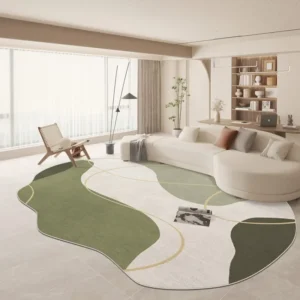Transform Your Space: Mastering the Art of Using Rugs to Define Living Zones
Have you ever stepped into a room and felt instantly drawn to a cozy corner, only to realize it’s just a matter of a well-placed rug? Rugs do more than merely decor; they play a vital role in defining living zones, enhancing comfort, and adding warmth to your home. In this article, you will learn how to master the art of using rugs to transform your space into distinct, inviting areas.
We will explore various styles, sizes, and placements of rugs, share expert tips for choosing the right one, and offer a roadmap for creating seamless living spaces. If you’re ready to elevate your home décor, keep reading to uncover the secrets of rug styling!
Understanding the Importance of Rugs in Interior Design
Rugs serve as crucial elements in interior design. They create a foundation for furniture arrangement and help convey a cohesive style. A well-chosen rug can:
- Define different areas in open floor plans.
- Add texture and warmth to any space.
- Enhance color schemes and aesthetics.
- Provide comfort underfoot in high-traffic areas.
The Psychology of Space and Rugs
Utilizing rugs effectively can evoke feelings of comfort and tranquility. When you segment spaces with rugs, you guide your guests to various parts of your home. This segmentation can generate a more inviting atmosphere. Research shows that visually defined spaces help individuals feel more at ease, making rugs an essential tool in your interior design arsenal.
Choosing the Right Rug for Your Living Zones
Not all rugs are created equal. The right choice depends on various factors, including size, material, and style. Here’s what to consider:
Size Matters
Selecting the correct rug size is critical in defining living zones effectively. Common sizes include:
- Area Rugs: Generally 5’x8’ or larger, ideal for defining larger spaces.
- Runner Rugs: Perfect for hallways or kitchens.
- Small Rugs: Best for accenting furniture pieces or cozy corners.
Material Choices
Rugs come in various materials, each with distinct advantages. For example:
- Wool: Durable and warm, great for comfort.
- Synthetic fibers: Stain-resistant and easy to clean, perfect for high-traffic areas.
- Natural fibers: Offer an organic touch, suitable for low-traffic spaces.
Style and Color Palette
Your rug’s style and color should complement your existing décor. Neutral tones can make a space feel larger, while bold colors can serve as statement pieces. Consider these matching techniques:
- Match the rug with key furniture pieces.
- Incorporate colors from your color palette for a cohesive look.
- Use contrasting patterns to add visual interest.
Placement Strategies: Creating Define Living Zones
Once you have chosen the perfect rug, the next step is determining the best placement. Here’s how to arrange your rugs to create distinct living areas:
Living Room Layouts
For a traditional layout, place the rug under the front legs of your furniture. This technique helps to visually anchor the seating area. Alternatively, a completely floored area with ample space around the rug creates an informal, relaxed vibe.
Dining Area Dynamics
In dining spaces, ensure the rug extends beyond the edges of the table and chairs. This will prevent chairs from snagging on the rug when pulled back, offering both comfort and style.
Defining Workspaces
For home offices or craft areas, use rugs to delineate your workspace. A smaller rug can provide a defined zone, encouraging productivity and focus.
Maintenance Tips to Extend the Life of Your Rugs
Keeping your rugs in pristine condition requires regular maintenance. Here are essential tips:
- Vacuum regularly to remove dirt and dust.
- Spot clean spills immediately to prevent stains.
- Rotate rugs periodically to ensure even wear.
Incorporating Rugs into Different Decor Styles
Rugs play well with various décor styles. Let’s take a look at how to incorporate them into some popular design themes.
Modern and Minimalistic
Choose solid colors or simple patterns to maintain an uncluttered look. Large, oversized rugs can enhance this aesthetic, providing a base for minimalist furniture.
Eclectic and Bohemian
Layering rugs is a common practice in bohemian styles. Mix various patterns and textures to create a visually stunning, collected-over-time look.
Traditional and Classic
Persian and Oriental rugs can add rich layers to traditional spaces. Opt for intricate designs and rich colors to anchor your living areas.
Case Studies: Real-World Rug Transformations
Urban Loft Redesign
A client wanted to separate a large loft into distinct living spaces. By selecting an oversized area rug, they defined the living area without closing it off. The rug not only added visual interest but also created an inviting atmosphere.
Cozy Farmhouse Revamp
In a cozy farmhouse setting, layering rugs helped divide the open kitchen and dining area, allowing for functional flow while maintaining a warm, homey feel.
Visual Content Suggestions
To enhance the reader’s experience, consider creating an infographic that illustrates various rug placement styles or before-and-after images showcasing effective rug use in different spaces.
Frequently Asked Questions (FAQ)
Can I use multiple rugs in a single room?
Yes, using multiple rugs can create a unique, layered look that adds depth and interest to your space.
How do I clean my rug without damaging it?
Refer to the manufacturer’s care instructions and consider spot cleaning or professional cleaning services for thorough maintenance.
What size rug should I choose for my living room?
A rug that extends at least 18 inches beyond the furniture helps to define the area better.
Are there rugs that are better for pets?
Yes, synthetic rugs are often more durable and easier to clean than natural fiber rugs, making them a suitable choice for pet owners.
What style of rug is best for a small space?
Light, solid-colored rugs can make a space feel larger, while a small patterned rug can add a touch of charm.
Mastering the art of using rugs to define living zones is an essential skill for any homeowner looking to enhance their space. By understanding size, material, and placement, you can create beautifully defined areas that resonate comfort and style. Remember to maintain your rugs regularly to ensure longevity, allowing them to serve as foundational elements in your home for years to come.
Ready to start your rug transformation? Explore our related articles for more tips on stylish room designs and décor choices!
Content Disclaimer
The information provided in this article is for educational purposes only. It is not intended to be professional financial advice. Please consult with an expert for specific guidance tailored to your needs.
Categories
- Accent Walls & Ceilings (17)
- Art Curation & Gallery (32)
- Bedding Style Trends (42)
- Bedroom Makeover (37)
- Bohemian & Eclectic Styles (17)
- DIY & Budget-Friendly Decor (16)
- Eco-Friendly Design (17)
- Furniture Care (36)
- Home Decor & Design Ideas (108)
- Home Wellness Spaces (17)
- Integrated Outdoor Living (16)
- Kids and Nursery Decor (17)
- Living Room Decor (37)
- Minimalist & Japandi Style (20)
- Mix & Match Techniques (36)
- Modern & Contemporary Design (16)
- Rug Sizing & Placement (36)
- Seasonal Home Decor (39)
- Small Space Solutions (21)
- Wall Art & Painting Tips (39)
Recent Comments
Archives
Product Gallery
-
 Large Area Green Rugs for Bedroom Nordic Living Room Decoration Shaped Carpet Irregular Plush Lounge Rug Home Thick Washable Mat Rated 5.00 out of 5$56.95 – $359.13Price range: $56.95 through $359.13
Large Area Green Rugs for Bedroom Nordic Living Room Decoration Shaped Carpet Irregular Plush Lounge Rug Home Thick Washable Mat Rated 5.00 out of 5$56.95 – $359.13Price range: $56.95 through $359.13 -
 Nordic Style Rugs for Bedroom Morandi Living Room Decoration Carpet Large Area Geometry Lounge Rug Home Cloakroom Non-slip Mat Rated 5.00 out of 5$40.93 – $620.00Price range: $40.93 through $620.00
Nordic Style Rugs for Bedroom Morandi Living Room Decoration Carpet Large Area Geometry Lounge Rug Home Cloakroom Non-slip Mat Rated 5.00 out of 5$40.93 – $620.00Price range: $40.93 through $620.00 -
 Irregular Shapes Living Room Decoration Carpet Modern Style Rugs for Bedroom Home Thicken Plush Rug Fluffy Soft Lounge Floor Mat Rated 4.75 out of 5$57.89 – $360.12Price range: $57.89 through $360.12
Irregular Shapes Living Room Decoration Carpet Modern Style Rugs for Bedroom Home Thicken Plush Rug Fluffy Soft Lounge Floor Mat Rated 4.75 out of 5$57.89 – $360.12Price range: $57.89 through $360.12















